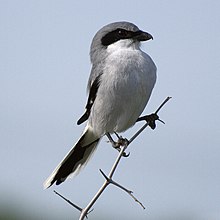Loggerhead shrike
| Loggerhead shrike | |
|---|---|
 |
|
| In Texas, USA | |
| Scientific classification | |
| Kingdom: | Animalia |
| Phylum: | Chordata |
| Class: | Aves |
| Order: | Passeriformes |
| Family: | Laniidae |
| Genus: | Lanius |
| Species: | L. ludovicianus |
| Binomial name | |
|
Lanius ludovicianus Linnaeus, 1766 |
|
The loggerhead shrike (Lanius ludovicianus) is a passerine bird. It is the only member of the shrike family endemic to North America; the related northern shrike (L. excubitor) occurs north of its range but also in the Palearctic. It is nicknamed the butcherbird after its carnivorous tendencies, as it consumes prey such as amphibians, insects, lizards, small mammals and small birds. Due to its small size and weak talons, this predatory bird relies on impaling its prey upon thorns or barbed wire for facilitated consumption. The numbers of Loggerhead Shrike have significantly decreased in recent years, especially in Midwest, New England and Mid-Atlantic areas.
The Loggerhead shrike is a medium-sized passerine. "Loggerhead" refers to the relatively large size of the head as compared to the rest of the body. It measures approximately 9 inches from bill to tail. The wing and tail length is about 3.82 and 3.87 inches long, respectively. It weighs on average 50 grams, with a range of 45-60 grams for a healthy adult shrike. The adult plumage of the Loggerhead Shrike is grey above, with a white to pale grey breast and black tarsi and feet. The bird possesses a black mask that extends across the eyes to its bill, unlike that of the similar but slightly larger northern shrike. The wings are black, with a distinct white patch on the primaries. The tail is black edged with white and the irises are brown. The beak is short, black, and hooked, and contains a tomial tooth to help tear into prey. It is difficult to sex an adult Loggerhead Shrike in the field, as they are sexually monochromatic. However, several studies have reported sexual dimorphism in plumage and size traits. Juveniles possess a paler gray plumage that is subtly vermiculated.
There are eleven recognized subspecies of loggerhead shrike:
Miller, in 1931, suggested that the wing-chord-to-tail-length ratio was an important indicator for distinguishing between subspecies.Lanius ludovicianus migrans, found in eastern North America, can be distinguished from the western subspecies, L. l. excubitorides by wing length, tail length, and colour. L. l. migrans have a paler forehead than the top of the head. According to Mundy et al.’s 1997 study, there is a substantial genetic difference between the island subspecies L. l. mearnsi and the mainland subspecies L. l. gambeli due to a gene flow barrier between the two species.
...
Wikipedia

